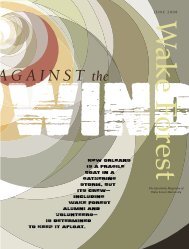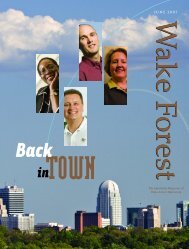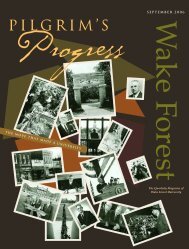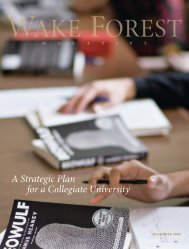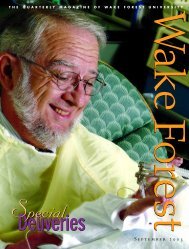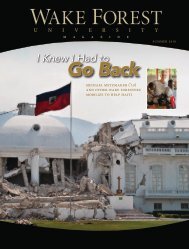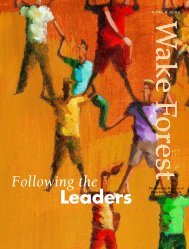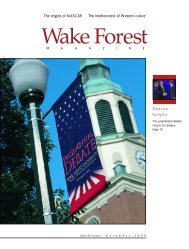Wake Forest Magazine, March 2007 - Past Issues - Wake Forest ...
Wake Forest Magazine, March 2007 - Past Issues - Wake Forest ...
Wake Forest Magazine, March 2007 - Past Issues - Wake Forest ...
- No tags were found...
You also want an ePaper? Increase the reach of your titles
YUMPU automatically turns print PDFs into web optimized ePapers that Google loves.
Discovery: Atala’s team makeshistory with groundbreakingstem-cell researchTHE LATEST ANNOUNCEMENTby the medical school’s Dr.Anthony Atala—that his team ofresearchers had discovered a newsource of stem cells in amnioticfluid that could be used to producea variety of tissue types—drew national attention and wascited on the floor of Congress bythose for and against embryonicstem-cellresearch.Atala, along with colleaguesfrom the <strong>Wake</strong> <strong>Forest</strong> School ofMedicine and Harvard MedicalSchool, reported that they hadused stem cells drawn fromamniotic fluid to create muscle,bone, fat, blood vessel, nerve,and liver cells in the laboratory.Their findings could lead tobreakthroughs in replacing damagedcells and tissue in treatingpatients with spinal cord injuries,diabetes, and Alzheimer’s, butpreliminary tests in patients arestill years away.“Our hope is that these cellswill provide a valuable resourcefor tissue repair and for engineeredorgans as well,” saidAtala, a senior researcher anddirector of the Institute forRegenerative Medicine. Atala’sfindings—the result of sevenyears of research—were first publishedin January in the scientificjournal Nature Biotechnology.Atala and his colleaguesreported that they had discoveredthat a small number of stem cellsin amniotic fluid—estimated at1 percent—can give rise to manyof the specialized cell types foundin the human body, although theyaren’t sure exactly how manydifferent types. “So far, we’vebeen successful with every celltype we’ve attempted to producefrom these stem cells,” he said.The newly discovered cells mayrepresent an intermediate stagebetween embryonic stem cellsand adult stem cells.Amniotic stem cells comefrom the fluid surroundingunborn babies and their placentas.Atala’s team obtained thecells using placentas or fluidfrom amniocentesis, a medicalprocedure commonly performedon unborn children to test forgenetic diseases. Because amnioticstem-cellresearch doesn’t harmthe fetus, Atala’s research avoidsthe controversy that surroundsembryonic-stem-cell research.President Bush vetoed legislationlast year that would haveAtalaeased restrictions on federallyfunded embryonic-stem-cellresearch. In January, the sameweek that Atala’s research wasreleased, the U.S. House againpassed legislation supportinggovernment-funded research.The Senate had yet to take upthe issue by late January.Both sides in the House debateused Atala’s research to supporttheir positions, even as he cautionedthat amniotic stem cellsshould not be considered areplacement for embryonic oradult stem cells.“It is essentialthat National Institutes of Healthfundedresearchers are able tofully pursue embryonic-stem-cellresearch as a complement toresearch into other forms ofstem cells,” he wrote in a letterto Congress.Atala’s announcement wasthe latest advance in regenerativemedicine to come from his teamsince he moved to <strong>Wake</strong> <strong>Forest</strong>three years ago from Harvard University.Last year, he and his colleaguesrebuilt bladders for sevenyoung patients using tissue grownfrom the patient’s own cells.A R O U N D T H E Q U A Dwww.wfu.edu/wowf MARCH <strong>2007</strong> 3




